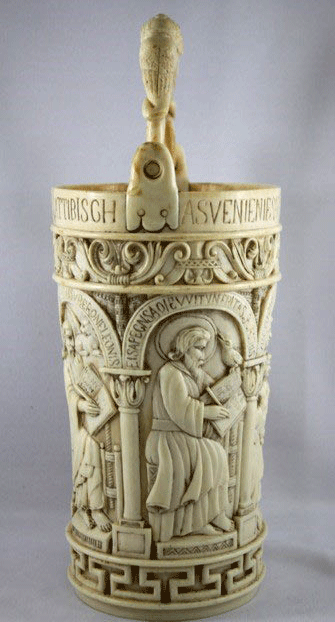Patricia Anderson, ‘Ivory Bans in the Art World: Will Australia Follow Suit?’, Daily Review, 5 January 2015

Our distant cousins, possibly even our Neanderthal ones, carved mammoth ivory into splendidly observed human and animal forms such as reindeer, bison, lions and horses or engraved them on ivory and bone fragments (picture below). Tens of thousands of years later, the discovery of the intricate Nimrud ivories, (9th to 7th centuries BC) named for the ancient Assyrian city of Nimrud in modern-day Iraq where they were found — and which were used to decorate furniture and chariots — would find their way to the British Museum, among other destinations.
The ivory came from Syrian elephants, once a fixture of the Middle East in antiquity but hunted almost to extinction by the 8th century BC. From this time on, elephant ivory had to be imported from India. Welcome to the world of global trade — and the appropriation of treasures from other lands.
In February last year, America announced a ban on the importing of ivory. This was just two days before a conference on illegal trafficking of elephant ivory took place in London. Put crudely, this meant a total prohibition of all African elephant ivory entering the country, with one exception: ‘antique’ ivory, if it could be proved the item was more than 100 years old.
Naturally enough, the art and antiques trade is concerned about the terminology in this legislation and would like a clear distinction to be made between modern carvings, which appeared after international action was taken against the trade in ivory in the 1980s, and ivory carved and sold before this time.
Directors of American museums are suggesting this ban on imports will jeopardise their lending of objects to museums abroad for exhibitions, and will discourage international museums lending artefacts to American museums for fear they might be impounded and not returned. Planned acquisitions in ivory have been derailed. While the Metropolitan Museum in New York was able to borrow 40 ivories from abroad for an exhibition Assyria to Iberia at the Dawn of the Classical Age it has ceased acquiring any artworks containing ivory.
So where does this leave the pianos with ivory keys? Where does it leave the countless thousands of European Mediaeval Christ figures on the Cross? Where does it leave collectors of Japanese netsukes, Baroque carvings, or the miniature 18th century portraits painted onto wafer thin ivory slices if their owners choose to sell such works or give or bequeath them to museums?
In Australia, the auction houses are doing splendid business in the sales of Chinese art works, including ivory carvings, which in part reflects the eagerness of the growing Chinese community to reclaim their cultural heritage. So far, there have been no difficulties. In fact this writer last year purchased a fine Chinese ivory puzzle at a local auction and is crossing her fingers that it was a 19th century work.
Read the full article here.

